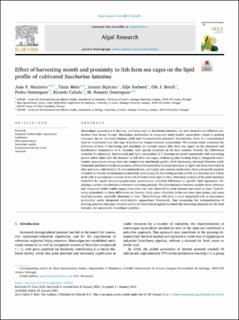| dc.contributor.author | Monteiro, João P. | |
| dc.contributor.author | Melo, Tânia | |
| dc.contributor.author | Skjermo, Jorunn | |
| dc.contributor.author | Forbord, Silje | |
| dc.contributor.author | Broch, Ole Jacob | |
| dc.contributor.author | Domingues, Pedro | |
| dc.contributor.author | Calado, Ricardo | |
| dc.contributor.author | Domingues, M. Rosário | |
| dc.date.accessioned | 2022-05-09T06:57:50Z | |
| dc.date.available | 2022-05-09T06:57:50Z | |
| dc.date.created | 2021-01-25T10:49:36Z | |
| dc.date.issued | 2021 | |
| dc.identifier.citation | Algal Research, 2021 (54), 102201, 1-13. | en_US |
| dc.identifier.issn | 2211-9264 | |
| dc.identifier.uri | https://hdl.handle.net/11250/2994653 | |
| dc.description.abstract | Macroalgae aquaculture is thriving, and kelps such as Saccharina latissima, are now farmed over different production sites across Europe. Macroalgae production in integrated multi-trophic aquaculture setups is gaining relevance due to increased biomass yield and bioremediation potential. Nevertheless, there is a substantiated need to understand how this type of production shapes biomass composition. The present study evaluated the influence of time of harvesting and proximity to nutrient source (fish farm sea cages) on the elemental and biochemical composition of S. latissima, with special emphasis on its lipid content. Overall, the differences recorded for elemental, biochemical and lipid composition of S. latissima occurred consistently with harvesting period rather than with the distance to fish farm sea cages, evidencing that farming kelp in integrated multi-trophic aquaculture setups does not compromise nutritional quality while promoting increased biomass yield. Elemental and biochemical composition differed between kelp biomass harvested in April and those harvested in May and June, with lower C, H and carbohydrates, and higher ash contents in the later. Fatty acid profile analysis revealed an increase in monounsaturated fatty acids along the harvesting period, as well as a decrease in n-3 fatty acids with a concomitant increase of the n-6/n-3 ratio from April to May. Statistical analysis of the polar lipidome identified by liquid chromatography-mass spectrometry revealed differences in specific lipid signatures, displaying a perfect discrimination between harvesting periods. The discrimination between samples from reference and integrated multi-trophic aquaculture sites was only observed for kelp biomass harvested in June. Contributing particularly to these differences are betaine lipids, more abundant in the two later time points, and some lysolipid species, especially abundant in June. These findings will allow a more integrated look at macroalgae production under integrated multi-trophic aquaculture framework, thus promoting the systematization of farming practices that may enhance yield with biochemical quality to match the increasing demands by the food industry and sustainable biorefinary pipeline. | en_US |
| dc.language.iso | eng | en_US |
| dc.publisher | Elsevier | en_US |
| dc.rights | Navngivelse 4.0 Internasjonal | * |
| dc.rights.uri | http://creativecommons.org/licenses/by/4.0/deed.no | * |
| dc.subject | Seaweeds | en_US |
| dc.subject | Polyunsaturated fatty acids | en_US |
| dc.subject | Nutritional quality | en_US |
| dc.subject | Mass spectrometry | en_US |
| dc.subject | Lipidomics | en_US |
| dc.subject | Integrated multi-trophic aquaculture | en_US |
| dc.title | Effect of harvesting month and proximity to fish farm sea cages on the lipid profile of cultivated Saccharina latissima | en_US |
| dc.type | Peer reviewed | en_US |
| dc.type | Journal article | en_US |
| dc.description.version | publishedVersion | en_US |
| dc.rights.holder | © 2021 The Authors. Published by Elsevier B.V | en_US |
| dc.source.pagenumber | 13 | en_US |
| dc.source.volume | 54 | en_US |
| dc.source.journal | Algal Research | en_US |
| dc.identifier.doi | 10.1016/j.algal.2021.102201 | |
| dc.identifier.cristin | 1878207 | |
| dc.relation.project | EC/H2020/727892 | en_US |
| dc.relation.project | Nordforsk: 82845 | en_US |
| dc.source.articlenumber | 102201 | en_US |
| cristin.ispublished | true | |
| cristin.fulltext | original | |
| cristin.qualitycode | 1 | |

